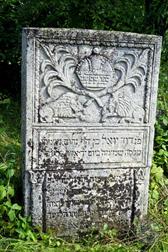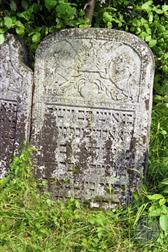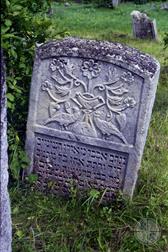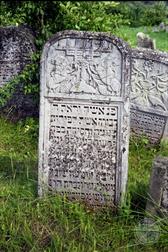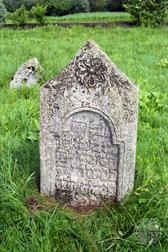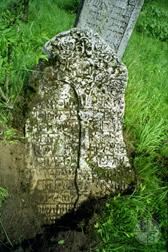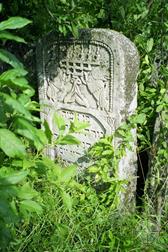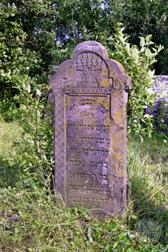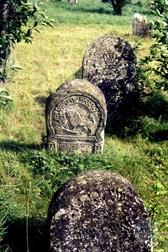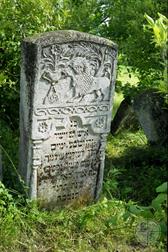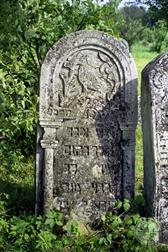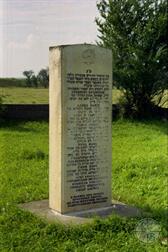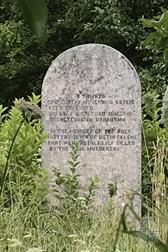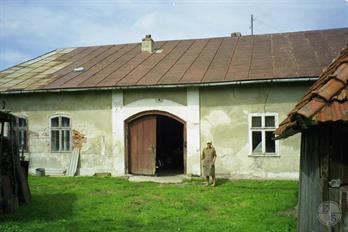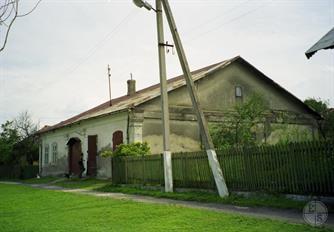Ustya-Zelene
Chortkiv district, Ternopil region
Year - Total Population - Jews
1765 - (?) - 280
1880 - 2,405 - 807
1900 - 2,442 - 597
1921 - 2,255 - 550
1931 - 2,412 - 573
1765 - (?) - 280
1880 - 2,405 - 807
1900 - 2,442 - 597
1921 - 2,255 - 550
1931 - 2,412 - 573
Sources:
- Pinkas Hakehillot Polin: Encyclopedia of Jewish Communities, Poland, Volume II, pages 62-63, published by Yad Vashem, Jerusalem. Translated by Ilana Kraus, JewishGen, Inc.
Photo:
- Benjamin Lukin, Center for Jewish Art: Jewish Cemetery in Ustya Zelene; Jewish Inn in Ustya-Zelene
- Collection of Alex Friedman. Jewish Ukraine
- Pinkas Hakehillot Polin: Encyclopedia of Jewish Communities, Poland, Volume II, pages 62-63, published by Yad Vashem, Jerusalem. Translated by Ilana Kraus, JewishGen, Inc.
Photo:
- Benjamin Lukin, Center for Jewish Art: Jewish Cemetery in Ustya Zelene; Jewish Inn in Ustya-Zelene
- Collection of Alex Friedman. Jewish Ukraine
Uscie Zielone (ukr. Ustya-Zelene, Устя-Зелене) was first mentioned in 1548 when it was granted the status of a town. Up to 1648, it was known as Uscie Horozana. In 1717, the town had 411 buildings.
The Jews of Uscie Zielone were first mentioned in 1552. In the seventeenth century, there was an organized Jewish community in the town whose jurisdiction also extended to the surrounding villages, inhabited by 187 Jews. The community's population peaked at the end of the nineteenth century. The Jews earned their livelihoods as innkeepers, small tradesmen, and craftsmen.
From the beginning of the twentieth century, the community of Uscie Zielone began to decline. The Jews of Uscie Zielone endured many hardships in the wake of WWI. In 1920, during the interim period between the retreat of the Polish army and the Bolshevik takeover, the Jews of Uscie Zielone suffered a great deal from the Petlura gangs, who murdered several local Jews. After the Polish regime regained control of the area, conditions for the town's Jews also improved.
The crafts industries in the town were mainly in the hands of the Jews, especially carpentry and tailoring workshops, bakeries and butcher shops. The town's market days were an important source of income for the local Jews. Seven of them had a de facto monopoly on the grain trade, exporting about three wagon loads per week to Stanisławуw. In the late 1920s, Jewish merchants controlled the trade in eggs destined for Lvov (about 25 crates per week); with time, however, the trade in eggs was taken over for the most part by Ukrainian cooperatives. A census taken during in the interwar period reported 21 Jewish craftsmen, 27 tradesmen, 11 salaried workers, 4 farmers, and 1 member of the free professions.
At first, Uscie Zielone's Jewish community functioned as a branch of the kehila in Buchach (Buczacz), but in the second half of the eighteenth century, an independent community was organized, which established its own institutions.
In the second half of the eighteenth century, Rabbi Zvi Hirsh Geller (died 1776), author of Or Zvi, served as the town's spiritual leader. Rabbi Yoseph Meir son of Rabbi Shmariyah-Shmerel Brandriess (died 1864) served as Uscie Zielone's av bet din and after his father Rabbi Shmariyah, av bet din of Zhomylov, went on aliyah to Eretz Yisrael, Rabbi Yoseph Meir took over that post as well. At the beginning of the nineteenth century, Rabbi Mordechai became the town's rabbi. In 1853, Shaul Halevi, son of Rabbi Meshulam Ish Horowitz, author of Beshamayim Rosh, served as rabbi of Uscie Zielone; in 1882, he took up the rabbinic post in Tyśmienica, where he died in 1912.
The Jews of Uscie Zielone were first mentioned in 1552. In the seventeenth century, there was an organized Jewish community in the town whose jurisdiction also extended to the surrounding villages, inhabited by 187 Jews. The community's population peaked at the end of the nineteenth century. The Jews earned their livelihoods as innkeepers, small tradesmen, and craftsmen.
From the beginning of the twentieth century, the community of Uscie Zielone began to decline. The Jews of Uscie Zielone endured many hardships in the wake of WWI. In 1920, during the interim period between the retreat of the Polish army and the Bolshevik takeover, the Jews of Uscie Zielone suffered a great deal from the Petlura gangs, who murdered several local Jews. After the Polish regime regained control of the area, conditions for the town's Jews also improved.
The crafts industries in the town were mainly in the hands of the Jews, especially carpentry and tailoring workshops, bakeries and butcher shops. The town's market days were an important source of income for the local Jews. Seven of them had a de facto monopoly on the grain trade, exporting about three wagon loads per week to Stanisławуw. In the late 1920s, Jewish merchants controlled the trade in eggs destined for Lvov (about 25 crates per week); with time, however, the trade in eggs was taken over for the most part by Ukrainian cooperatives. A census taken during in the interwar period reported 21 Jewish craftsmen, 27 tradesmen, 11 salaried workers, 4 farmers, and 1 member of the free professions.
At first, Uscie Zielone's Jewish community functioned as a branch of the kehila in Buchach (Buczacz), but in the second half of the eighteenth century, an independent community was organized, which established its own institutions.
In the second half of the eighteenth century, Rabbi Zvi Hirsh Geller (died 1776), author of Or Zvi, served as the town's spiritual leader. Rabbi Yoseph Meir son of Rabbi Shmariyah-Shmerel Brandriess (died 1864) served as Uscie Zielone's av bet din and after his father Rabbi Shmariyah, av bet din of Zhomylov, went on aliyah to Eretz Yisrael, Rabbi Yoseph Meir took over that post as well. At the beginning of the nineteenth century, Rabbi Mordechai became the town's rabbi. In 1853, Shaul Halevi, son of Rabbi Meshulam Ish Horowitz, author of Beshamayim Rosh, served as rabbi of Uscie Zielone; in 1882, he took up the rabbinic post in Tyśmienica, where he died in 1912.
Jewish cemetery and Memorials to victims of Holocaust, 1998
In 1860 Rabbi Mordechai son of Rabbi David became the town's spiritual leader. In 1885, Rabbi Yisrael Matityahu son of Rabbi Nachman Ze'ev Auerbach, author of Alufei Yisrael, Shomer Yisrael, and Omrei Bina, served as dayan and moreh tzedek (halakhic teacher), and possibly later on as av bet din in the town. Between the years 1882 and 1887, the town was served by Rabbi Yoseph son of Rabbi Meshulam Issachar Horowitz (died 1898), author of Alon Shvut. Rabbi Simcha son of Rabbi Moshe Bahbad was the av bet din and afterward took his father's place in Trembowla serving there until his death in 1917. Rabbi Mordechai son of Rabbi Shmuel Blech (or Shor) was the av bet din starting in 1905 and took part in the congress of rabbis in Lvov. Rabbi Mordechai Shor perished in the Holocaust in 1943.
Uscie Zielone's Zionist organizations included the Hatikva society, which was already in existence in 1899, and the Hatechiya society, founded in 1924. By 1925 there was an active branch of Ezra and in 1928 a branch of Achva was set up, which had 40 members by 1933 as well as a kibbutz-hachshara. In 1931, Uscie Zielone's branch of the Revisionist Movement set up a Betar youth movement group. In the 1931 elections to the Zionist Congress, the General Zionists won 17 votes; the Revisionists, 32; and the radical Zionists, 1 vote. In the 1935 elections, however, the strength of the General Zionists increased conspicuously; they received 136 votes, while Mizrachi received 8 and Hitachdut Poalei Zion, 3, and neither the Revisionists nor the Radical Zionists received any votes.
In 1927, 12 Jews were voted onto Uscie Zielone's city council and served together with 6 Poles and 13 Ukrainians.
We have no information about the fate of the Uscie Zielone community during the Second World War, aside from the fact that it was destroyed in 1942. In September or October of that year (apparently prior to the first aktion in nearby Buchach), the German authorities ordered the Jews of Uscie Zielone, as happened with the Jewish residents of the other towns in the area, to move within a week to Buchach. There they were caught in two aktions which took place in that city (on October 17, 1942, and November 17, 1942). The Jews of Uscie Zielone who survived these two aktions met the same fate as their brethren from Buchach, who were confined in a ghetto toward the end of 1942.
Uscie Zielone's Zionist organizations included the Hatikva society, which was already in existence in 1899, and the Hatechiya society, founded in 1924. By 1925 there was an active branch of Ezra and in 1928 a branch of Achva was set up, which had 40 members by 1933 as well as a kibbutz-hachshara. In 1931, Uscie Zielone's branch of the Revisionist Movement set up a Betar youth movement group. In the 1931 elections to the Zionist Congress, the General Zionists won 17 votes; the Revisionists, 32; and the radical Zionists, 1 vote. In the 1935 elections, however, the strength of the General Zionists increased conspicuously; they received 136 votes, while Mizrachi received 8 and Hitachdut Poalei Zion, 3, and neither the Revisionists nor the Radical Zionists received any votes.
In 1927, 12 Jews were voted onto Uscie Zielone's city council and served together with 6 Poles and 13 Ukrainians.
We have no information about the fate of the Uscie Zielone community during the Second World War, aside from the fact that it was destroyed in 1942. In September or October of that year (apparently prior to the first aktion in nearby Buchach), the German authorities ordered the Jews of Uscie Zielone, as happened with the Jewish residents of the other towns in the area, to move within a week to Buchach. There they were caught in two aktions which took place in that city (on October 17, 1942, and November 17, 1942). The Jews of Uscie Zielone who survived these two aktions met the same fate as their brethren from Buchach, who were confined in a ghetto toward the end of 1942.

- Home
- Shtetls
- Vinnytsia region
- Volyn region
- Dnipro region
- Donetsk region
- Zhytomyr region
- Zakarpattia region
- Zaporizhzhia region
- Ivano-Frankivsk region
- Kyiv region
- Kropyvnytskyi region
- Luhansk region
- Lviv region
- Mykolayiv region
- Odessa region
- Poltava region
- Rivne region
- Sumy region
- Ternopil region
- Kharkiv region
- Kherson region
- Khmelnytskyi region
- Chernihiv region
- Chernivtsi region
- Cherkasy region
- Crimea
- Synagogues
- Cemeteries
- Objects & guides
- Old photos
- History
- Contact
Jewish towns of Ukraine
My shtetl
My shtetl
Donate
Jewish towns of Ukraine
